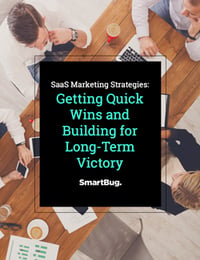
3 Essential Components of a Digital Marketing Strategy for SaaS Companies
May 24, 2021
So you’re a software-as-a-service (SaaS) company looking to perfect your digital marketing strategy? You’ve come to the right place.
If you’re trying to make your strategy fit into a digital marketing strategy for any industry other than SaaS, you’re pretty much comparing apples with oranges. In a crowded industry, it's now more important than ever to find ways to stand out from the crowd. What makes the SaaS industry different from the rest?- SaaS values long-term customers. It’s not just a “purchase and forget about it” business model.
- The SaaS Buyer’s Journey is a lengthy process. It can take anywhere from 6-18 months to close an enterprise deal
- There is so much competition. Martech solutions grew by 13.6 percent in one year alone.
I think I’ve made my point: SaaS can’t be treated like the sole orange among an orchard of apples. The key to success is incorporating three main components into your SaaS digital marketing strategy.
1. Perfect Your Buyer Personas
You may have heard the term buyer personas, but when was the last time you revisited yours and adjusted it to match your current landscape? The SaaS industry is constantly evolving. In the age of digital transformation, what may be the norm on a Monday could look completely different come Friday.
Buyer personas should be constantly evaluated and applied to each piece of content your organization produces. Whether it’s through blog content, premium content pieces like white papers or e-books, or even social media content, you should always be crafting copy to answer your buyer personas’ pain points.
2. Evaluate Your Existing Content Strategy
As mentioned above, crafting content based on your buyer personas is key to success. But how do you evaluate your current content strategy to ensure that it is producing results and getting you to your goals? As marketers, showing your ROI is the be-all-end-all, especially if you’re presenting campaign analytics to a board of advisors that may not understand the importance of a digital marketing strategy.
Run a Content Audit
Start by pulling a list of all of the content that currently lives on your site, from blog posts to premium content pieces. Look at what’s performing well and, more importantly, what’s not.
Read through the content and ask yourself, is this still relevant? Is this answering my persona’s questions? Is this providing another action for this person to take to learn more? If the answer is no to any of these, either remove it or adjust it to better fit your current goals.
Set Your S.M.A.R.T. Goals
Your SaaS digital marketing strategy should always include several moving parts, each with different goals. Your strategy should always be tested, tinkered with, and evolved. Some people look at strategy as a daunting task, but it’s one that should never be skipped. With every successful digital marketing strategy, S.M.A.R.T. goals should follow suit.
What is a S.M.A.R.T. goal? It’s a goal that meets the following guidelines:
- Specific: Make sure your goals are precise and align with the greater company goals.
- Measurable: Set goals that can be measured, such as “Get 100 content downloads.”
- Attainable: Make sure your goals are realistic and competitive.
- Relevant: Ensure goals align with the campaign topic.
- Timely: Always set a timeframe for your goal.
An example of a S.M.A.R.T. goal for a SaaS digital marketing campaign could be SmartBug Media® would like to increase website traffic by 12 percent in Q4 2021.
3. Don’t Try to Make Your SaaS a One-Size-Fits-All Solution
Traditionally, organizations have relied on what I like to call a “horizontal strategy,” meaning that your marketing efforts span across your entire database. One of the hottest trends for SaaS companies in 2021 is incorporating a vertical focus.
A vertical focus is much different—it is persona-based and product-specific. Many SaaS companies offer multiple products and solutions, and it’s important to not market absolutely everything you offer to absolutely everyone.
Incorporating a vertical strategy allows marketers to customize and craft messages for each buyer persona looking for a very specific product or service offering. This type of messaging should be laser-focused, and it tends to be more cost-effective due to its product and solution-focused content.
Never Stop Fine-Tuning
Gone are the days of printing 1,000 marketing brochures only to have the content expire in 30 days. The beauty of digital media is that it can be changed. If a web page isn’t performing to your liking, you can go in and adjust and tinker with it until it produces the results you’re looking for.
One of the biggest takeaways I can stress is to never stop fine-tuning your digital marketing strategy. The world around us constantly evolves, and your strategy should, too.

About the author
Heather Hiltzik is a senior director of account strategy at SmartBug Media. She leads a team of strategists and works with clients on SEO, analytics, lead generation, sales enablement, customer success, and inbound marketing strategy. Heather got her MBA in marketing at the University of Illinois. In her spare time, she loves to travel and spend time with her husband and three rescue dogs. Read more articles by Heather Hiltzik.









